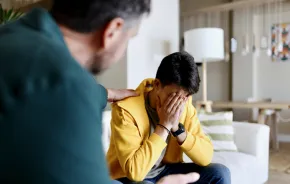It's a little bit easier to watch TV
this month. The video of crying children with large, frightened eyes
has been replaced by video of bulldozers and earth-moving machinery.
Earth is the operative word here: We want to feel grounded again. We
saw what the water moved and took away, and some of us still can't wrap
our minds around the magnitude of this loss.
It is not so much the images of walls of water that distressed our
children. As tidal waves go, this was not -- in most cases -- what
Hollywood has told us one would look like (think "Hawaii 5-0" or "Day
After Tomorrow"). It's not the oddball view of watching cars and buses
floating along and parking themselves in trees (or boats).
One tsunami story bothered children more than the tsunami itself:
Hearing that parents sometimes had to choose which of their children
would live or die. While this story has a nightmarish effect on all of
us as parents, the impact increases geometrically on children. Any kids
that heard that story asked themselves the awful question: Would I have
been let go?
It's easy to tell ourselves that such a disaster could not happen here,
and from the safety of the front seat of the car, or the big pillow on
the sofa, assuage the fears that such a choice would ever present
itself in our tidy lives. But our children quickly point out that we
are on the Pacific Rim, where earthquakes -- and thus tsunamis -- can
happen. So they won't want to ask us that question.
Watching television showing a natural disaster shouldn't be all about
inoculation (Quick! Change the channel! Turn it off!), but about
empowerment. When a disaster like that occurs (not again within any of
our lifetimes, we hope), the first activity must be to ask your child,
"How do you think we can help?" This approach reminds children that
even though the other side of the world is experiencing a catastrophe,
this side of the planet can experience compassion -- and put it to good
use. You will be surprised at the passion and enthusiasm you can tap
into. It is, in fact, quite a wave of its own.
And as you discuss this with your children, you can point out that the
parents whose children were swept up by the tsunamis did everything
they could to save their families -- just as you would. You can make a
disaster plan saying where you would meet in the event of a family
emergency. You can choose a preventive measure (a tsunami warning
system, for example) and ask your children to write a letter to our
government, and those governments around the world, supporting such an
action.
The very last thing we should do is to say nothing and let our children
rewrite "Sophie's Choice" in their heads -- in living color.
With older children, you may be able to put December's images in a
different perspective. This month, and every month, more people will
die of diarrhea (149,000) malaria (165,000) and AIDS (240,000) than in
the recent tsunamis. Yet for every $100 of national income, the United
States gives 15 cents to developing nations. Add in private donations,
and the amount reaches a whopping 21 cents. Based on our share of the
population, out of 22 "civilized" countries, we ranked last.
We don't see those pictures. We don't hear those stories, or if we do,
we don't put faces on them. But they are there. And in three or four
months, when the impact of Dec. 26, 2004, begins to be felt in
far-reaching social and economic terms, will we remember the images
that swept us to our checkbooks and computers?
We have to. We owe it to our children, as well as to the ones who
slipped away. In remembering, and continuing to act, no one is truly
let go.
Lynn Ziegler
has been media critic for Seattle-based Action for Media Education
since 1991. Her book, Spongeheadz: U & MEdia will be published in
2005.
Tsunami relief: Where to give
- American Red Cross: visit the Web site at www.redcross.org/donate.html and choose options for donating online, by mail or phone.
- World Concern (Seattle): donate online at www.worldconcern.org
or by check (make out to World Concern Tsunami Relief Fund) and mail to
World Concern, 19303 Fremont Ave. N., Seattle WA, 98133. - World Vision (Federal Way): donate online at www.worldvision.org, or via phone at 1-888-511-6593.









